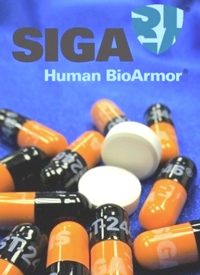
Scientists are questioning a $433-million government contract for an experimental smallpox drug (ST-246) awarded to Siga Technologies by the Obama administration. Siga, a New York-based pharmaceutical company specializing in disease-causing pathogens, was given a contract in May through a “sole-source” procurement: It was the only company asked to submit a proposal, while the government reportedly blocked other companies from bidding after Siga nearly lost the contract a year ago.
The Los Angeles Times reported over the weekend that administration officials used deceitful measures to secure the contract, as Sigas controlling shareholder is one of the worlds wealthiest men and a prominent Democratic Party donor. Interviews, email correspondence, and various documents revealed that the Obama administration replaced the projects lead negotiator after Siga complained that contracting specialists at the Department of Health and Human Services (HHS) repelled its financial demands.
Critics question the contract, especially in light of the fact that smallpox is no longer a threat. The Times reported:
Once feared for its grotesque pustules and 30% death rate, smallpox was eradicated worldwide as of 1978 and is known to exist only in the locked freezers of a Russian scientific institute and the U.S. government. There is no credible evidence that any other country or a terrorist group possesses smallpox.
If there were an attack, the government could draw on $1 billion worth of smallpox vaccine it already owns to inoculate the entire U.S. population and quickly treat people exposed to the virus. The vaccine, which costs the government $3 per dose, can reliably prevent death when given within four days of exposure.
Sigas contract requires delivery of 1.7 million doses of the drug for the countrys biodefense stockpile, in the case of a bioterrorist attack. ST-246, an antiviral drug used to treat smallpox, is intended to treat people who were diagnosed with the infectious disease too late for the vaccine to work. However, the drug has not been approved by the FDA and ethical constraints have hindered human testing of the drug; further, it is unknown whether animal trials could prove it would effectively treat humans. Moreover, the vaccine is only reportedly effective if applied within four days after contracting the disease.
Many analysts and scientists question the price, which exceeds $250 per dose, and the effectiveness of the drug. Dr. Donald Henderson, an epidemiologist who directed the global eradication of smallpox for the World Health Organization and later assisted in organizing biodefense efforts under President George W. Bush, believes this level of protection is unnecessary. “Weve got a vaccine that I hope we never have to use how much more do we need?” he asked, adding, “The bottom line is, weve got a limited amount of money.”
Dr. Thomas Mack, a research physician at the University of Southern Calirfornias Keck School of Medicine who has counseled the FDA on the virus, called the plan “a waste of time and a waste of money.”
But despite concerns about whether the drug will work, or whether it is even necessary, the contract was aggressively pursued by the Obama administration. As it turns out, the pharmaceutical companys controlling shareholder is billionaire investor Ronald Perelman, who foresaw a lucrative opportunity for the company after the Bush administration suspected Saddam Hussein of harboring smallpox and biological weapons and after President Bush signed Project BioShield in 2004, a $5.6-billion program to develop and stockpile medications to combat bioterrorism. Perelman thought he had found the best customer Siga could serve: the U.S. government.
The Times chronicled the timeline of the project:
From 2005 through September, the company has paid three lobbying firms $800,000 to represent its interests in Washington, public records show. Disclosures filed by the lobbyists said they focused on Project BioShield and “issues related to homeland security and HHS,” along with “government procurement of vaccines.”
Perelman and others at Siga’s affiliate, MacAndrews & Forbes, have long been major political donors. They gave a total of $607,550 to federal campaigns for the 2008 and 2010 elections, according to records compiled by the Center for Responsive Politics. About 65% of that money went to Democrats. Perelman donated an additional $50,000 to President Obama’s inauguration.
From December 2007 to January 2011, Sigas chief executive worked on the National Biodefense Science board, advising on how to counter biological terrorism and other national health emergencies. In June 2010, Siga welcomed to its board Andrew Stern, former president of the leftist Service Employees International Union (SEIU) and an active presence in the Obama White House. SEIU shoveled out a whopping $28 million for Obamas 2008 campaign, making it the “organization that spent the most to help Barack Obama get elected president.”
On October 13, 2010, Siga reported that the federal government planned to award it a contract for ST-246 worth nearly $3 billion. Sigas stock price surged, and the company attributed its financial fortunes to its generous federal contract: “Our ability to generate near-term revenue is particularly dependent on the success of our smallpox antiviral drug candidate.”
Chimerix Inc., a North Carolina company who also applied for the contract, complained that Siga was too large a company, as the federal contract restricts applicants to only small businesses with no more than 500 employees. The Small Business Administration investigated the companys complaint and found that Chimerix was indeed the only eligible small-business applicant. The Times noted that the government could have reopened the bidding to companies of all sizes to expand competition and find the best firm with the best price.
But instead, the Obama administration blocked all other companies from bidding on a second contract offering. Administration officials rationalized that Siga was the only company capable of meeting the five-year timetable for the antiviral smallpox drug. This of course raised eyebrows among contract official within HHS, with one official averring that the administrations excuse for creating a no-bid agreement was a “stretch.” Nevertheless, Siga was touted as the only company capable of meeting the needs of the nations biodefense strategy.
In February, HHS retracted the original contract and asked Siga to submit a new proposal, which spurred a bargaining frenzy between Siga and government officials. After reviewing the proposal, HHS negotiators decided $170 per treatment was a “fair and reasonable price.” Naturally, company officials dissented. “Siga did not derive its price based on any cost information, and, from Siga’s viewpoint, such information is not relevant to determination of an appropriate price,” chief financial officer Daniel Luckshire protested in a March letter to HHS. “Siga has created extremely valuable intellectual property, embodied in ST-246, and Siga has priced ST-246 based on the value of that intellectual property.”
A bargaining stalemate goaded Sigas chief executive Dr. Eric Rose to write the governments main negotiator requesting a “more senior official [with] the authority to take into account the important policy issues that surround this procurement.” Two days later Dr. Nicole Lurie, a presidential appointee who manages biodefense planning at HHS, responded assuring Dr. Rose that they would appoint a new lead negotiator. An analyst for RBC Capital Markets announced to investors in May that the final negotiated price was calculated to $255 per dose, $85 more than original proposal by the HHS. In the end, Siga got its way.
The blatant cronyism detailed in this scandalous saga compiled by the Los Angeles Times, of course, raises the inevitable question: Is Siga the next Solyndra?



